SERBIA









There are a myriad of ways in which you can get to know Ser bia: through active holiday in the wonderful nature, acquainting yourself with a variety of cultures and the wealth of its heritage, having fun at the night clubs and famous floating raft clubs, taking part in the joyful atmosphere of the EXIT festival, Guča and numerous other festivals, enjoying sincere hospitality of village households and healthy cuisine with Serbian specialties, or sail ing down the beautiful blue Danube River, discovering exquisite harmony of nature and culture, and the largest gorge in Europe.
And there are countless other reasons for the visit. We suggest starting the adventure by reading this short story about Serbia.


The capital of Serbia takes pride in its Belgrade Fortress and Kalemegdan Park with a romantic view of the conflu ence of the Sava into the Danube. We invite you to feel its artistic spirit at Kosančićev Venac, its galleries and muse ums; to experience its bohemian atmosphere in Skadarlija cafes; the fun atmosphere in around 500 clubs, boat clubs and cafes; the sports spirit on Ada Ciganlija, one of the most beautiful city islands in the world; the business air in New Belgrade, where you will also find the largest Bel grade shopping malls. The prestigious guide Lonely Planet has positioned Belgrade on the first place in the top-list of ten cities providing the best nightlife in the world.

The Temple of St. Sava – one of the largest Orthodox tem ples in the world and one of the most prominent features of Belgrade skyline.


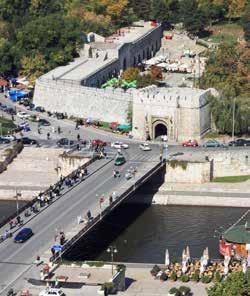
The second largest city in Serbia, 80 km north-west of Belgrade, Novi Sad is both a traditional and a modern city elegantly placed on the Danube. This is the city in which Albert Einstein lived with his spouse Mileva Marić. Novi Sad is famous for its multicultural spirit and a mixture of architectural styles –gothic, baroque, secession, neoclassi cism, modernism. What features as the symbol of Novi Sad and Vojvodina is the Fortress of Petrovaradin – a picnic grounds, art centre, planetarium, place of nightlife and the EXIT music festival.
The birthplace of Emperor Constantine the Great, Niš is the third largest city in Serbia, situated 240 km southeast of Belgrade. Niš is the Balkans in a nutshell – it is the intersection of his tory, tradition, lifestyles and mentalities creating the magnificent spirit of this city. Monuments, museums and archaeological sites (Mediana, the Niš Fortress, the Skull tower, etc.), as well as the promenade street, music and festivity account for an entirely authentic experience!
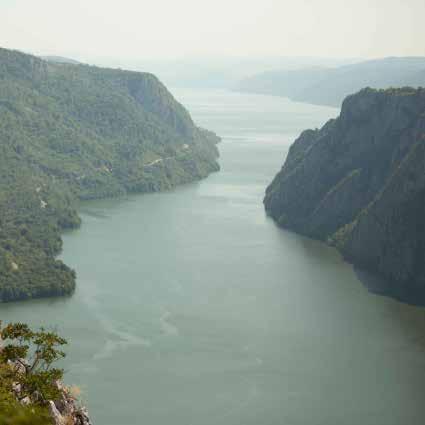
SERBIA – THE HEART OF THE DANUBE
On its way through Serbia, the Danube River runs along the most astonishing geographical, geological, cultural and historical sites. The Danube is navigable on its whole course through Serbia (588 km) and constitutes part of the Pan-European Transport Corridor VII, providing ample opportunities for sailing and enjoyment. In Serbia the Danube flows from the Pannon Plateau in the North to Djerdap, the largest river gorge in Eu rope, inviting you to take an inspiring trip enjoying the stunning views of intact nature, centuries-old culture, towns with their distinctive features and dynamic everyday life of multicultural communities. What best characterizes the Danube flow in Serbia is a perfect har mony between natural and cultural heritage.
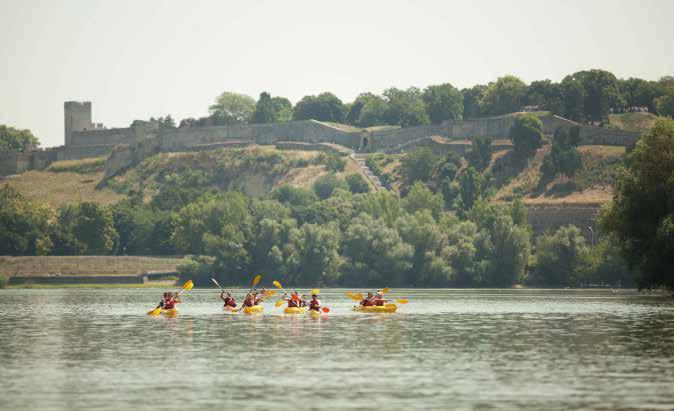
Serbia, which has always been at the world’s crossroads, has inherited products of various cultural influences which can be recognized in its numerous museums, galleries, archaeo logical sites, churches, in its festive spirit, music, food and customs. Don’t miss on getting acquainted with the culture dating to 7,000 and 5,500 years BC – at the archaeological site Lepenski Vir, located on the Danube, you will discover testi monies of people who created the first great myths of the man and the Earth, invented brilliant construction solutions and made extraordinary fish-like sculptures. Vinča archaeological site, in the immediate vicinity of Belgrade, will introduce you to the scopes of the oldest metallurgy culture (5,000–4,500 years BC) formed in the first true pre-historic metropolises.


The exquisite Serbian heritage from the Antic period will take you back to the time when Roman legions marched here fighting the barbaric tribes on the Danube riverbanks. In the period be tween the third and the fifth century, the area of today’s Serbia, from a mar ginal border territory, became the heart of political and cultural life in the Ro man Empire. You, too, can walk along The Roads of Roman Emperors, across Sirmium (Sremska Mitrovica), one of the four capitals of the Roman Empire, Singidunum (Belgrade) or Viminacium (Kostolac near Požarevac), one of the most significant military camps and Antic towns. Visit the amazing works of Roman construction (Diana, Pontes, Traian’s Road, etc.), Felix Romuliana (near Zaječar), which was recognized as part of the World Heritage by UNESCO, Naissus and Mediana (Niš) and Justini ana Prima (near Leskovac).
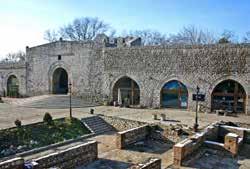
As many as 16 Roman emperors were born on the territory of today’s Serbia! Among them was the first Christian Roman em peror, and one of the founders of Christi anity, Constantine the Great. The central celebration of 17 centuries of The Edict of Milan was held in 2013 in Niš, Constantine’s birthplace.

Serbian art brought unique solutions reflected in the synthesis of elements of Romanic, Gothic and Byzantine art. You can best explore this by visiting Orthodox monasteries and churches which are the masterpieces of Serbian medieval paint ing and architecture, making an essential chapter in the UNESCO’s list of world’s cultural heritage. The monasteries of Djurdjevi Stupovi, Studenica, Žiča, Sopoćani and Gradac are part of the Cultural
Route of the Council of Europe Transromanica, connecting European monuments of the Romanic style (www.transromanica.com).
Make sure you experience the superb combination of Serbian natural and cul tural riches on the slopes of Fruška Gora.

This national park prides on its 16 mon asteries, the true gems of Serbian baroque painting.
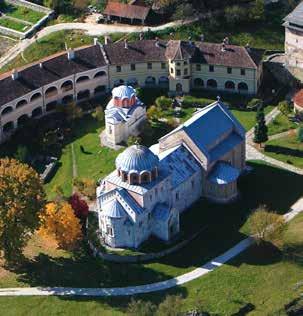 Studenica Monastery
Vrdnik – Ravanica Monastery, Fruška Gora
Studenica Monastery
Vrdnik – Ravanica Monastery, Fruška Gora
The fortresses erected along the Dan ube riverbanks testify of the turbulent past and borders which were once set there. Make sure you visit the Belgrade Fortress from where you can enjoy the stunning view of the confluence of the Sava into the Danube, the Smederevo Fortress, the sometime capital of Serbia, the Petrovaradin Fortress, also known as the “Danube Gibraltar”, where you can wander through a sys tem of tunnels and corridors. We also recommend visiting the fortresses of Bač, Ram, Golubac and Fetislam.
UNESCO World Cultural Heritage in Serbia:
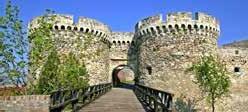

– Stari Ras and Sopoćani

– Studenica Monastery
– Medieval Monuments in Kosovo* (Patriarchate of Peć Monastery, Church of the Virgin of Ljeviša, and Gračanica and Dečani monasteries)
– Gamzigrad-Romuliana, Palace of Galerius
– Stećci Medieval Tombstones Graveyards**
* The Autonomous Province of Kosovo and Metohija is currently administered by the United Nations Interim Administration Mission in Kosovo (UNMIK), according to the UN Security Council Resolution 1244.
** Trans-boundary property in Bosnia and Herzegovina, Croatia, Montenegro, Serbia
Serbia is one of ecologically most preserved plac es in Europe! We invite you to explore the wealth of its five national parks and more than thirty parks of nature and special nature reserves. Diverse and attractive places in Serbia offer un forgettable adventures and experience – sailing on the widely flowing Danube, trekking in the Serbian mountains hiding an entire universe of flora and fauna, recreational fishing in the still lowland waters or quick foaming mountain waters of fairy-tale beauty, demanding cycling paths which will take you to the most exquisite sights...
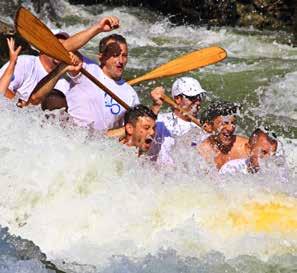
The national park Fruška Gora, which used to be an island in the Pannonian Sea a long time ago, today emerges from the vast fertile Vojvodina lowlands. We invite you to come to Fruška Gora to sense the fragrance of lin den forest, accounting for more than 30% of the woods in Fruška Gora, which is a unique case of such concentration in Europe. Eques trian sport lovers can visit the horse farm Karadjordjevo, belonging to the eponymous special nature reserve, famous for hunting tourism, among other.
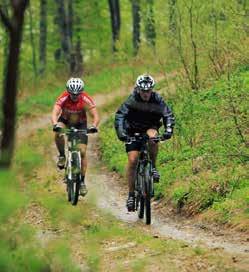

The national park Djerdap with the Djerdap Gorge, the longest and the largest gorge in Europe, whose “Iron Gate” connects two important cultural and economic parts of Europe, is a strategic place of vital importance which has witnessed an intense life since prehistoric times. On account of its mild climate, a com plex net of gorges, canyons and deep ravines, this place is singled out as a unique European resort of tertiary flora, vegetation and fauna. Due to the specific crossing of winds and the width of the Danube, this place can rightly be called a sailing heaven.
Obedska Bara (pond) in Vojvodina is part of UNESCO’s world list of important swamp habi tats for around 220 bird species, 50 mammal spe cies, 13 amphibian spe cies, 11 reptile species, 16 fish species, some 180 fungi species, 50 moss species and up to 500 plant species.
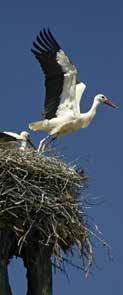
In the far west of Serbia there is the national park Tara, and as much as 80% of the national park is covered by mixed forests of spruce, fir tree and beech. There is Pančić

Spruce (Picea omorica), world endemic species, growing on Tara. The very terrain configuration makes Tara suit able for various recreational activities: mild slopes are convenient for long walks, horse riding, different sports games, trim paths, etc. The project “Tarocikl” has defined 27 cycling paths with the length of about 420 km, placed along the landscapes of stunning beauty.
The national park Kopaonik is located in the central part of Serbia with over 1,500 plant species out of which 91 are en demic and 82 subendemic spe cies. At the peaks of Kopaonik the sky is clear 200 days a year on average. In the mountain ridge there are sharp peaks, gentle pastures, valleys, mixed and evergreen forests. Kopaonik is the best known ski-centre in Serbia.

The national park Šar Mountain* is situated in the far south of Serbia. The clash of the Mediterranean and continental climate has resulted in the appearance of different microclimatic variations. While at the foot, in the valleys, one senses the warm Mediterranean climate, on the highest peaks it is cold and cruel, Alpine, so the snow can stay on the ground even 280 days a year.
* The national park Šar Mountain is situated on the territory of the Autonomous Province of Ko sovo and Metohija, see note on page 11.

Serbia can offer so much more for a true adventure of returning to the na ture! From the Lake of Palić, to the Deliblato Sands, sometime desert and today’s wooded oasis, the Cave of Re sava ornamented with mineral jewellery, the Ovčarsko-Kablarska Gorge, Zlatibor Mountain and Stara planina (Balkan Mountains) to the Devil’s Town – a won der of nature with earthen pillars covered by caps at the top. These and many other beautiful monuments of nature are sim ply breathtaking.
Meanders of the Uvac Canyon, probably among the most beautiful panoramic images of Serbia, are the largest habitat of the Griffon Vulture in the Balkans.
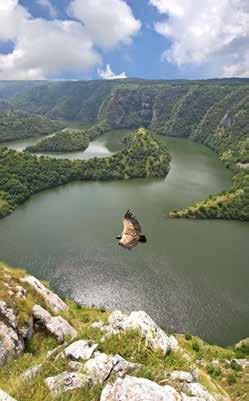
Do you long to get away from the city crowd and en gage in invigorating activities? What Serbia has in store for you are its beautiful villages. The rhythm of life in a village is the rhythm of nature, change of seasons, the rhythm of heartbeat – the only true natural order. Lying on the riverbanks, lined up in the infi nite lowlands, scattered in the mountain slopes and peaks, covered by woods, plum trees and vineyards, the villages of Serbia have an air of peace and quiet. Moreover, the hospitality offered by the villagers completes the enjoyment. The warm welcome is not a matter of training; it is cordial, simple and natural, as if directed to dear guests, cousins.
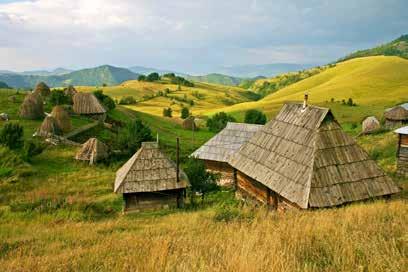
To eat: barbecue, beans, gibanica cheese pie, ajvar, sauerkraut rolls, goulash, fish broth, Banat sausages.

To drink: natural juice, slivovitz, quince brandy, wine, beer.
Serbia is the second world producer of raspberries. Our raspberry has the best quality, taste and is most beneficial for your health, as the climatic conditions are particularly suited to its production.

In Vojvodina you will encounter a number of village farm houses, salashes. There you will enjoy everything: the food, drink, the sound of the tambura. You can only relax and take a rest, or go hunting and fishing, you can cycle or learn how to ride a horse, sail on a boat or ride in a coach, swim, water ski or sleigh on a frozen pond, you can try to do some old crafts or folk art.
If you prefer village idyll, you can find it in the villages of Central Serbia. These villages, whether they are located near Arandjelovac, Topola, Gornji Milanovac, Čačak, Knić, Lučani, Kruševac, Kralje vo, Aleksandrovac or in the vicinity of Kopaonik, nurture a tradition of well-be ing of their land. These villages are situ ated near rivers, springs and streams, at the foot of various mountains, offering a fulfilling vacation on which, depending on the season, you can go fishing, hunt ing, skiing, swimming, horse riding, col lecting medical herbs and forest fruits, walking, cycling, preparing food and win ter preserves together with hosts, grape picking, etc.
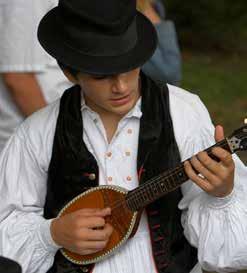

The landscape of West Serbia is something of a natural aquarelle, as one curve overflows into an other towards the horizon. This scenery is made of mountains covered by evergreen forests interspersed with streams. There are numerous village households. Whether they be ethno villages like Kosjerić, Sirogojno and Mećavnik, or the usual village house holds on the slopes of Mokra Gora, at the foot of Zlatibor near the town of Užice, on the banks of the emerald Drina River, the houses have been built of natural material. Most of them are made of wood, and all details in the interior are chosen with love and care, in line with the style of this part of the country.
Drvengrad is an ethno-village in Mokra Gora with wooden houses built by the famous film director Emir Kusturica.

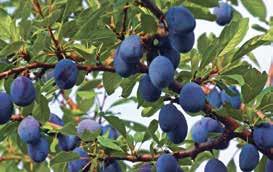
Owing to its unique beauty, Pirot’s rug has become a widely known and renowned product. Pirot’s rug is smooth on both sides and its ornaments are always geometric shapes with pronounced colour contrasts and red as the dominant colour.

The traditional cuisine offers a wide range of interesting dishes. If you are in a mood for a walk after a good meal, all roads lead to the nature. At the end of July the famous “Drina Regatta” invites you for a special event – a downhill river race with hedonistic treats for both the eye and the ear. Your thirst for unusual experiences will be further satisfied by the railway Šargan Eight in Mokra Gora, a masterpiece among the world’s rails of narrow gauge.
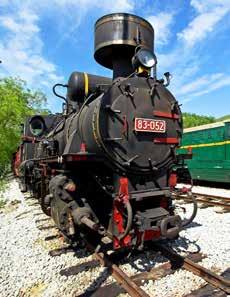
Wherever you go in the East Serbia, from the powerful Djerdap to the wonderful vil lages around the Lake of Bujanovac, you are in for a surprise. You will discover that it is here more than anywhere else in Serbia that the boundaries between reality and legend be come blurred. Numerous village households near Donji Milanovac, Kladovo, Golubac, Majdanpek and Negotin practice village tourism. In East Serbia, the Timok Borderland is fa mous for its vineyard tradition. Visit “Rajačke pivnice”, a unique architectural complex of 270 wine cellars which emerged during the period between the mid-18th century and 1930’s. Make sure you explore Rtanj Moun tain, the Homolje Mountains split by the clean and clear Mlava River, with the spring of Mlava, Krupajska river and the vanishing river of Homolje, the “Veliki Buk” waterfall and still intact nature, which are true gems of both East Serbia and Serbia in general.

Ten stages, some of the best music performers and bands in the world and magnificent surroundings. The EXIT backstage is the fantastic medieval Petrovaradin Fortress built on the Danube riverbank. According to the Guardian, this is one of the most important festivals in Europe, visited by approxi mately 200,000 people during the four-day period of time. We invite you to be part of this unique and exciting event.

At this authentic celebration and competition of traditional Serbian music, the sound of the trumpet is heard non-stop during both day and night. Within the music event you can visit interesting exhibitions of local handicrafts, treat yourself with substantial portions of the typical national cuisine and sip exquisite domestic wine. This explosive mixture is exactly what makes Guča so attractive to an increasing number of vis itors every year. In 2010 the 50th anniversary was celebrated by 800,000 guests from Serbia and abroad.


At this festival, apart from the wide range of beers and ales, you can also enjoy live music and domestic food. Each year, dozens of beer brands and bands are fea tured, attracting around 500,000 visitors during five days in mid-August. The program also includes social campaigns targeting environmental and humanitar ian issues. Its constant advancement in all segments guarantees that this event will be offering great fun in the coming years as well – an experience no visitor shall forget.
Nowhere else does jazz sound as unique as it does here. What makes this sound so special is the ambience of the Niš City Fortress, where the festival takes place annually. Over the years, it has become the “jazz centre of gravity” in the region. Besides pro viding entertainment to visitors, the festival offers an opportunity for per formers to hold workshops and share a part of their artistry with other fellow musicians.
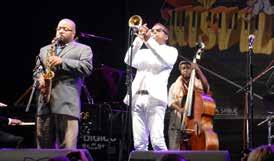
Tourist Information and Souvenir Shop
National Tourism Organisation of Serbia
In the city
Makedonska 22, 11000 Belgrade
Tel: +381 11 6557 127
E-mail: info@serbia.travel
Trg Republike 5, 11000 Belgrade
Tel: +381 11 3282 712
E-mail: info@serbia.travel
At Belgrade airport
Tel: +381 11 2097 828
E-mail: info-aerodrom@serbia.travel
Belgrade Nikola Tesla Airport has an ideal location at the crossroads of major air routes with 25 airlines connecting the capital of Serbia with 62 destinations throughout Europe, Middle East, North Africa and USA in scheduled, charter and cargo traffic. Airport “Nikola Tesla” www.beg.aero
Every traveller eager to experience exciting ad ventures can also reach Serbia by train or bus: The Serbian Railways www.zeleznicesrbije.com
You can find useful information for your ar rival and stay in Serbia on the website of the National Tourism Organisation of Serbia www.serbia.travel

Belgrade Bus Station www.bas.co.rs
You can get familiar with the road conditions and obtain useful advice if you are traveling by car or motorbike through Serbian Auto mobile Association (AMSS): www.amss.org.rs
To those who like cycling around the world, we recommend taking the Serbian part of the Danube cycling route EuroVelo 6, and obtain the information on other cycling routes via The Cycling Federation of Serbia: www.bss.rs Ciklonaut www.ciklonaut.com
Publisher: National Tourism Organisation of Serbia Čika Ljubina 8, 11000 Belgrade Tel: +381 11 6557 100
Fax: +381 11 2626 767 E-mail: office@serbia.travel www.serbia.travel
serbiatourism serbia
Marija Labović, CEO/Managing Director
Editor: Dejan Crnomarković
Author: Bojana Ilić
Design: Marijana Markoska, PhD
Translated into English by: Aleksandra Marić
Photographs: Dragan Bosnić, Dragan Vildović, Branko Jovanović, Slobodan Bibić, Hiishii, EXIT photo team, NTOS archive
Printed by: Službeni glasnik, Jovana Ristića 1, 11040 Belgrade
Circulation: 25,000 9th edition in English language, 2019 ISBN 978-86-6005-488-5
CIP - Каталогизација у публикацијиНародна библиотека Србије, Београд 338.48(497.11)(036)
ILIĆ, Bojana, 1982Serbia highlights / [Bojana Ilić ; translated into english by Aleksandra Marić ; photographs Dragan Bosnić ... [et al.]]. - 8th ed. in English language. - Belgrade : National tourism organisation of Serbia, 2017 (Belgrade : Službeni glasnik). - 23 str. : fo togr. ; 15 x 15 cm
Izv. stv. nasl.: Србија атракције. - Poda tak o autorki preuzet iz kolofona. - Tiraž 25.000. ISBN 978-86-6005-488-5
a) Србија - Водичи COBISS.SR-ID 228795404
www.serbia.travel